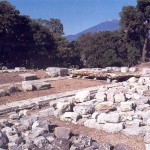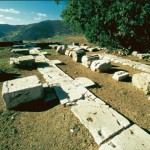Map
Photo gallery
Archaeological Site Ano Louson
Lousoi was an important city of Arcadian Azania (such was the name on the Kleitora northwestern Arcadia), a holy nation-wide, the temple of Artemis Agenda. Located on the southwest side of the extension of Aroania mountains (Helmos), in particular in the western foothills of Lucius terms or Prophet Elias, in the valley of Soudena between Kynetha and Kleitoros.
Tradition connects the sanctuary of Artemis with the seer Melampus (The Chief Psychiatrist of antiquity) that there cured of madness, with the intervention of the goddess, the daughters of the king of Tiryns Proetos great-granddaughter of Danaos.
As a token of gratitude to the goddess daughters introduced female dances, they founded a sacred grove where he erected an altar which erainan blood of goats and sheep. Since then, the residents named Artemis Daily, Day, one that imerefei everything. In honor of the goddess was a great celebration, the DAY, in competitions where they took place and foreigners. Artemis was then “day” (good-natured, benevolent) with offerings and rituals in the sanctuary of.
Near Lousoi village of Kalavryta Municipality, the Austrian Archaeological Institute has brought to light the great Arcadian town Lousoi while excavations are continuing. They excavated the temple of Artemis Daily, was built 3rd century BC century, the city market and many private residences.
In 1886 the first C. Papandreou detected the actual position of the church and the city. In 1898 and 1899 with the permission of the Greek Government W. Reichel and A. Wilhelm excavating the hill sacred. The excavation uncovered the foundations of the church and the main buildings of the sanctuary, not confined to the sanctuary and did not include city, which is at a lower level. The excavation of the sanctuary continued in 1981 under the supervision of the Director of the Austrian Archaeological Institute Veronica Mitsopoulou-Leon and since 2000 under the supervision of the new Director, Georg Ladstätter. Additional excavations began on the foundations of the temple of Artemis in order to confirm the dating, and Georg Ladstätter prepared a new draft of the plan of the temple. In addition, east of the Temple of Artemis, brought to light a pit with a significant number of offerings, dating from the Late Geometric and Archaic period, and oblong building, probably earlier temple of the great temple.
The ruins date back to the late 4th century BC and early 3rd century. BC, where the sanctuary flourished. But sure and use an older church after finding a piece of the marble statue of the goddess, dated the 6th century. BC Also found in the sacred silver and bronze coins in the form of Demeter and Zeus Omagyriou and inscriptions.
The area surrounding the ancient town has been declared an archaeological site, and the site of the temple is visited for the public.

